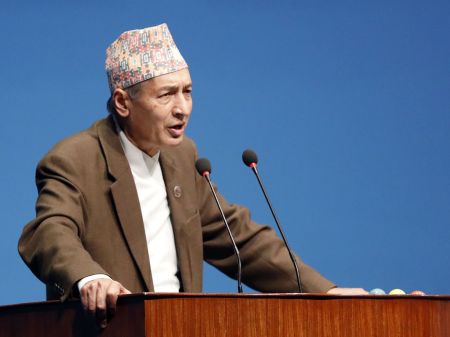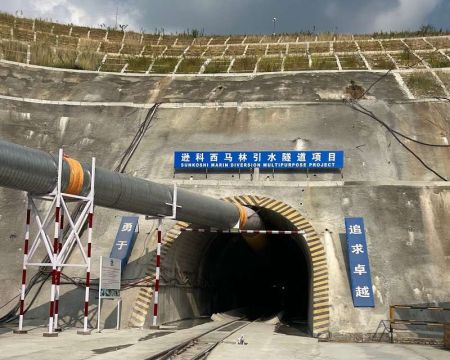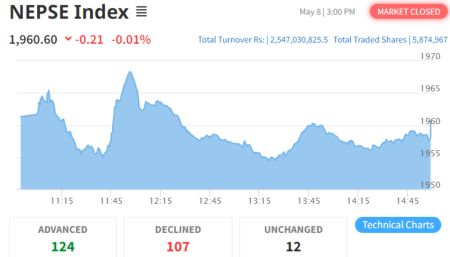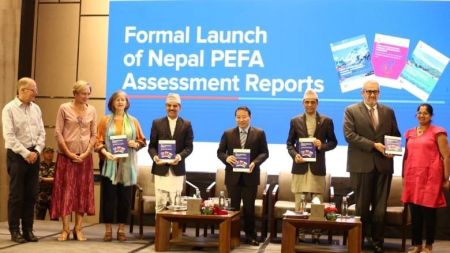By Newbiz team
Nepal has been going through a significant economic transformation over the years, transitioning from an agrarian economy to a service-oriented one. In fact, the nation has embraced the service sector as a major driver of its economic growth. Although the growth of Nepal's service sector has not been very rapid, its contribution to the national GDP is significant. According to the Economic Survey 2022/23, the service sector's growth rate in the fiscal year 2022/23 was estimated at 2.3%, down from the previous year's 5.3% growth. Despite this slight decline, the sector's average growth rate over the past decade has been a decent 4.5%. This growth has played a crucial role in shifting the economy's focus from agriculture to services.
Similarly, the service sector's contribution to Nepal's Gross Domestic Product (GDP) has been on an upward trajectory. In 2020/21, the service sector contributed 61.2% to the national GDP, and by 2021/22, this figure had risen to 61.4%. The trend is projected to continue, with an estimated contribution of 62.4% in 2022/23. This demonstrates the sector's increasing importance in driving economic expansion and development within the country.
Trade in services covers intangible transactions across various fields, including business and professional services, communication services, finance services, and more. The global significance of this sector cannot be underestimated, as it constitutes the largest segment of the global economy, accounting for approximately 70% of the global GDP, 60% of global employment, and 46% of global exports measured in value-added terms. While these figures may not be as impressive for Nepal, the country's service sector has certainly made significant progress. However, despite domestic growth, Nepal has not fully leveraged the potential of international trade in services. International trade experts highlight both challenges and opportunities that the country faces in expanding its presence in the global services market.
Despite the high domestic growth of the service sector, Nepal has not fully harnessed its potential in international trade in services. The country's external balance still reflects a relatively smaller size of services exported, excluding remittance inflow. In 2021/22, Nepal received Rs 122.084 billion from services exports, a notable increase from Rs 79.070 billion in 2020/21. In the first 11 months of the previous fiscal year, which ended in mid-July, there was further growth, with income from services exports amounting to Rs 168.533 billion.
While Nepal's competitiveness in goods trade lags behind, there is an increasing urgency for both the government and the private sector to intensify their efforts in diversifying services exports. A 2021 study conducted by the Ministry of Industry, Commerce, and Supplies, under the Nepal India Regional Trade and Transport Project, reveals that Nepal possesses significant competitive advantages and vast potential within the service sector. The country benefits from abundant and cost-effective human resources across various areas within the service sector, further bolstering its potential for development.
Trade in services holds immense promise for Landlocked Developing Countries (LLDCs) like Nepal due to its minimal reliance on transport and transit facilities. As a result, promoting services trade becomes a more promising avenue compared to merchandise trade. Notably, the service sector has emerged as a robust and forward-looking driver of Nepal's economy in recent years, experiencing significant growth. Impressively, trade in services has accounted for nearly 70% of the total convertible foreign exchange earnings, while merchandise trade has only contributed 13%.
Dr Posh Raj Pandey, the chairman of South Asia Watch on Trade Economics and Environment (SAWTEE), points out that while there is potential for growth in Nepal's international trade in services, the actual progress has been limited. “Despite possessing ample potential, the country has yet to fully capitalise on the opportunities presented by services trade, hindering the realisation of larger benefits from this sector,” observes Dr Pandey.
Nepal’s Trade Strategy
As Nepal endeavours to unlock the full potential of its services trade, there is a need for concerted efforts to address any existing barriers, foster an enabling environment, and leverage the identified high-potential service sectors. By doing so, the country can bolster its economic growth and international standing, paving the way for a more prosperous future. However, the strategies adopted by the government for international trade have been traditional, focusing on only trade in goods, rather than trade in services.
In 2010, the government came up with the Nepal Trade Integrated Strategies (NTIS) which identified tourism and labour services as highly promising exportable services for the country. Additionally, IT and BPO services, along with education, were categorised as having moderate export potential. On the other hand, health, engineering services, and hydroelectricity were placed in the low potential category for export. Experts say service exports can effectively diversify the country's export basket, leading to a more resilient and robust economy by reducing the ballooning trade deficit.
Similarly, NTIS 2016, a revised strategy consisting of nine goods and three services to boost high-value product exports, has placed significant emphasis on promoting specific sectors with substantial export potential. These earmarked sectors include tourism (encompassing leisure, business, education, and medical services), Business Process Outsourcing (BPO) and Information Technology (IT) services, as well as Engineering and labour services (which generate remittances) as key contributors to Nepal's export growth. However, it is worth noting that among the identified sectors, only labour services and tourism have demonstrated strong performance. Other sectors, despite their potential, couldn’t achieve similar levels of success.
The government revised its international trade strategy yet again in early 2023 and unveiled it as the NTIS 2022. It has earmarked Rs 463 billion for the implementation of the strategy aimed at increasing the country’s exports to Rs 2 trillion over the next five years. Instead of learning lessons from the failure of the past two trade strategies (NTIS 2010 and 2016), the government has focused only on merchandise trade in NTIS 2022 as well, while continuing its traditional approach toward the trade in services.
For landlocked nations, the trade in services becomes even more important because it serves as a crucial economic lifeline for them. However, Nepal has yet to prioritise this facet of trade. It is evident that policymakers have limited their focus to sectors such as travel and tourism, information technology-enabled services, and a select few others deemed exportables. They have never tried to come out of their ‘comfort zone’ and explore the possibilities in service sub-sectors such as financial services (e.g. banking and insurance), health, education, retail, and accountancy, among others.
Financial Services
According to trade analysts, it is high time Nepal seriously considered the export of financial services. The development of ICT infrastructures, increasing air and land connectivity and the expansion of the domestic financial sector all present a lot of opportunities to generate cash by exporting these services. Export of financial services refers to the provision of financial products and services by a country or a financial institution to clients located in other countries. It involves the cross-border delivery of various financial activities, such as banking, insurance, asset management, investment advisory, brokerage, and other related services.
Nepal may not be in a position to export all of them right now but it can certainly begin with banking and finance services. Nepal is a developing country with a growing financial sector. Nepal's financial sector mainly comprises commercial banks, development banks, finance companies, microfinance institutions, insurance companies, reinsurance companies and capital market entities.
The export of financial services from Nepal is relatively limited due to various factors, including the size of the economy, the level of financial development, and the regulatory framework. Most of Nepal's financial institutions have not yet established a significant presence in international markets or expanded their operations beyond the country's borders. However, Global IME Bank has taken some steps, opening a representative/contact office at Aldershot, Hampshire in the United Kingdom (UK) five years ago. Through this representative/contact office in the UK, the bank has been assisting in trade and investment management between business professionals. Before the UK contact office, the bank had established similar contact offices in Sydney, Australia and New Delhi, India.
“We plan to establish representative/contact offices gradually in other countries also,” says Chandra Prasad Dhakal, the chairman of the bank.
Similarly, among the several insurance companies and two reinsurance companies in the country, only Nepal Reinsurance Company (Nepal Re) - the nation's first reinsurer - has been exporting reinsurance services. According to the Nepal Insurance Authority, an average of Rs 14 billion is being sent out of the country annually for reinsurance purposes. Citing this fact, the authority has urged Nepali insurers to reinsure at least 10% of their businesses with Nepali reinsurance companies.
Established in 2014 as a government undertaking, Nepal Re has been earning premiums collected from insurance companies in countries such as Bhutan, India, Zambia, Kenya, Kuwait, Maldives, Papua New Guinea, the Philippines, Togo, Vietnam, and Malaysia. According to the annual report of Nepal Re, the Nepali company received recognition as a 'reinsurer' from the regulatory body of India in 2018. It aims to explore new global markets in the coming days.
In fiscal year 2021/22, Nepal Re was successful to expand its business by 18.22% to Rs 12.36 billion. As of mid-January 2023 in the current fiscal year, the company has collected Rs 3.349 billion in premium. With a notable growth in its business, the company has been successful to curb the outflow of money from domestic insurers on the one hand while it has been increasingly receiving business from companies abroad.
According to a report of Swiss Re entitled ‘Sigma Report-2022’ the total global insurance market increased 3.4% to $6.860 trillion. Provided Nepali reinsurers win the trust of the global market, they are likely to give the country notable earnings from the segment.
Nepal experiences an evident disparity in its international trade of insurance and pension services. During the initial 10 months of the previous fiscal year 2022/23, Nepal's exports in this sector amounted to a mere Rs 1 billion, while imports surged to a substantial Rs 9.91 billion. These figures highlight a pressing need for the country to implement effective policies that stimulate and support the growth of its international trade in insurance and pension services. By adopting the right strategies and initiatives, Nepal can create an environment that encourages domestic insurers and pension providers to expand their reach and compete globally. Addressing this trade imbalance is crucial for bolstering the country's insurance and pension sectors and maximising their contribution to Nepal's overall economic development.
To enhance its ability to export financial services, Nepal can take several measures to develop and strengthen its financial sector. Some strategies that Nepal can consider include regulatory reforms, infrastructure development, capacity building and talent development, financial inclusion, collaboration with international partners, investor-friendly policies, market development, branding and marketing etc. By implementing these strategies, Nepal can enhance its financial sector's capabilities, improve its regulatory environment, and position itself as a more attractive destination for exporting financial services. However, it is important to recognise that building a competitive financial services industry takes time, and Nepal would need to be persistent in its efforts to achieve significant progress.
Healthcare
This sector was identified for its good export potential by the NTIS-2010. However, when the national trade policy was revised in 2016, the government removed the sector from the export list. Nevertheless, healthcare carries the potential of being a valuable service export from Nepal, according to experts. The Tilganga Institute of Ophthalmology (TIO), for example, has been attracting patients not only from neighbouring countries but also from East Asian nations. TIO has also been exporting intraocular lenses to countries including China, Pakistan, South Africa, Cambodia, Thailand, Sri Lanka, and Vietnam. The institute has been producing and exporting high-quality lenses since 1995.
The TIO exported 219,000, 158,000 and 263,000 pairs of lenses in 2014, 2015 and 2016, respectively. It has been exporting an average of 700,000 pairs annually since 2018.
Some private sector healthcare institutions namely Norvic International Hospital, Grande International Hospital, Nepal Cancer Hospital and Nepal Mediciti Hospital are already providing services to foreign patients.
CIWEC Clinic, a healthcare unit that provides medical services to the expat community, has undergone significant expansion since its establishment in 1982. Starting as a small clinic, it has evolved into a full-service hospital cum travel medicine centre, offering both outpatient and inpatient care. Initially focused on providing medical services to expats, the clinic later expanded its services to serve other people as well. In September 2014, the hospital further extended its reach by opening a new unit in Pokhara, catering to the growing need for an international standard healthcare facility in this bustling tourist city.
Amish Pathak, the chief of operations at Kist Medical College, stated that the demand for medical professionals has been increasing internationally. According to Pathak, countries like the Maldives and Mauritius are experiencing a surge in demand for doctors, while the United Kingdom and Australia have a high demand for staff nurses. “As these professionals are paid higher, they can bring in a large amount of foreign currencies,” he added.
Recently, several hospitals have introduced a special program called 'Trekkers' Help' as part of their travel packages. This initiative has proven to be beneficial in assisting tourists in the local areas," Pathak said.
According to Pathak, Nepal is making significant progress in the field of organ transplant, with a particular focus on kidney transplants. Stating that the cost of kidney transplants in Nepal is comparatively cheaper than in neighbouring India, many Indian nationals prefer visiting Nepal for the procedure. Pathak also expressed that these medical services could be expanded to African countries, including Kenya.
However, Pathak acknowledges the challenge of a shortage of technical manpower in the country. “Because of this, we have been unable to provide proper report readings even after conducting lab tests accurately, leading medical service-seekers to rush to Indian hospitals for a second opinion,” he added.
Accountancy/Chartered Accountancy
The NTIS 2016 has identified professional services as having high export potential. Chartered Accountancy services are among the services that fall under this category, as stated by the Ministry of Industry, Commerce, and Supplies. According to records from the Institute of Chartered Accountants of Nepal (ICAN), approximately 12,000 students are currently pursuing the CA degree. Additionally, a significant number of students have been studying in India.
Sudarshan Raj Pandey, a chartered accountant and past president of ICAN, stated that Nepali institutes have upgraded the CA curriculum to international standards. He mentioned that the curriculum now encompasses financial reporting measures, accounting system measures, tax laws, corporate laws, among other subjects.
Pandey said that Nepali CAs are increasingly engaged in international non-governmental organisations and international institutions like the Asian Development Bank and the World Bank.
“The demand for Nepal-produced CAs by foreign organisations is seeing only nominal growth. As many countries have their own criteria for the selection of technical manpower, we need to develop customised courses including an extensive application of the IT, rather than depending on the conventional methods of the education system,” Pandey added.
ICT Services
The Information and Communications Technology (ICT) sector is one of the fastest-growing sectors in Nepal, with tremendous potential for continued growth in the near future as well. This dynamic sector comprises various sub-sectors and services, including Communications Services (Internet, telephone, mobile communication) and IT services, which encompass IT Enabled Services (ITES) and Business Process Outsourcing (BPO).
Some of the prominent companies offering BPO services in Nepal include Verisk Information Technologies, Deerwalk, Javra Software, Leapfrog, F1Soft, Incessant Rain Animation, and Cloud Factory. Many of these Nepali companies provide services to clients in Europe, America, Australia, and other Asian countries. The IT-BPO industry has the potential to become a catalyst for tech-based job creation in Nepal, similar to neighbouring countries like India, the Philippines, and Vietnam, while also contributing to the growth of the services sector.
The swift digital economy, including digital payment, e-commerce, and the app economy, is also experiencing significant growth.
“The lack of both physical and digital infrastructure, including electricity supply, internet connectivity, and access to technology, can limit the growth of the IT sector and hinder its expansion," says Urisha Bajracharya, project manager at Technorio Inc.
Infodevelopers ICT Awards, Computer Associations of Nepal (CAN), Nepal Association of Software & IT Services Companies (NASIT), boot camps, and training programs have helped to flourish the IT sector in the country. The sector is attracting international clients, leading to an increase in the country's exports of IT products and services. This creates new career opportunities in international business, trade, and export management. The development of the IT sector is driving innovation and digital transformation across various sectors, such as healthcare, education, tourism, and finance.
In 2000, the Government of Nepal recognised IT as a priority sector with the vision of placing Nepal on the world IT map by 2005. However, this goal could not be realised due to the country's energy crisis. After the end of 'load-shedding' in 2017, accompanied by an increase in internet access, the potential for exporting IT-related services has been steadily growing. The IT industry in Nepal, which primarily comprises IT-enabled services, consulting, and BPO, has the potential to drive structural transformation.
A special provision was even introduced in the Finance Act to encourage the export of IT services. The government reduced the tax to only 1% for individuals and entities that have earned foreign currency during the fiscal year 2022/23 via IT service business like BPO, software programming, cloud computing etc. Earlier, the tax rate on export of IT services was as high as 20%.
Such tax concessions can also be an effective tool in attracting foreign investment into the IT sector. However, this incentive has been introduced only for a specific year which is not very encouraging for long-term investment plans and technological development.
Another area where policy intervention is needed is the opening up of outward foreign investment by IT companies. Experts opine that removing barriers to investing should remain a focus of the government. A good place to start, with immediate effect, is to fast-track investment clearance. Currently, it takes over eight months for an existing foreign investor in an operating IT company to get regulatory clearance to inject further capital. Making it easier for Nepali diaspora to invest in the tech sector in Nepal can be another area that needs reforms.
Among the underlying challenges are lack of skill and high communication gap, limited innovative thinking, and a mindset of working solely for others. There is also a lack of government support and incentives, a shortage of software engineering experts, no proper association for IT professionals, and difficulties in receiving cross-border payments.
Nepal enjoys a favourable trade balance in the telecommunication, computer, and information services sub-sector. During the initial 10 months of the previous fiscal year, Nepal successfully exported services in this category valued at Rs 13.34 billion, while imports amounted to a comparatively lower figure of Rs 1.27 billion. These statistics clearly indicate that Nepal has the potential to thrive in this service sub-sector, provided that the government implements the appropriate policies. By adopting proactive measures and creating an enabling environment, Nepal can capitalise on its strengths and bolster its competitiveness in telecommunication, computer, and information services.
Travel and tourism
The tourism sector is the largest service industry contributing significantly to the Nepali economy through employment generation and foreign exchange earnings. There are numerous sub-sectors related to tourism that have the potential to be further developed, leading to an even greater contribution to the economy.
According to a report by the World Travel and Tourism Council, the tourism sector of Nepal experienced a growth rate of 5.3% in 2018. Unfortunately, the COVID-19 pandemic severely affected the sector for nearly two years. Prior to the pandemic, the council had estimated the country's tourism sector to grow by 5.2% annually from 2018 to 2028, accounting for 32% of the total exports.
All the three editions of the NTIS have recognised tourism as a high-potential exportable service for the country. Recently, entrepreneurs have also identified significant potential in the growth of Nepal's tourism sector.
Hotels and hospitality centres in the country have the capacity to accommodate around 3.5 million tourists. With approximately 10,000 hotels ranging from five-star establishments to tourist standard hotels, Nepal offers a diverse range of accommodation options.
At present, there are 18 five-star hotels, including one deluxe hotel, in the country, according to the Hotel Association of Nepal (HAN). Additionally, around 20 more five-star hotels are scheduled to be added within the next one and a half years. Moreover, over two dozen hotel chains are also prepared for operation. HAN President Binayak Shah emphasised that the recent rebound of business in the sector demonstrates Nepal's potential to significantly boost its service trade through the promotion of the tourism industry.
Ramesh Thapa, president of the Nepal Association of Tour and Travel Agents, stressed the need for implementing well-structured programs to accelerate the revival of tourism. He emphasised the promotion of the country's main tourist destinations, along with expanding the services of travel agencies, ticketing, and mountaineering training abroad, among other measures.
A World Bank report states that Nepal has great tourism potential because of its natural beauty, bio-diversity ethnic, linguistic, and social diversity; and historical and cultural wealth. Tourist arrivals have grown from just over 6,000 in 1962 to nearly a million of visitors a year, recently.
The international lending institution has, however, underlined a need for investment in tourism-related infrastructure, enhancement of quality and skills of related manpower, proper regulation and monitoring and adoption of a comprehensive approach to developing the sector. “Developing Nepal as an attractive, safe, and sustainable tourism destination requires a holistic approach wherein the government, the private sector, and public-private partnerships work collectively to meet stated objectives,” according to the World Bank.
Nepal holds a favourable balance in its international trade in travel services. In the first 10 months of the fiscal year 2022/23, the country exported travel services worth Rs 48.92 billion while the import stood at Rs 27.34 billion.
Repair and maintenance services
Trade in maintenance and repair services is a service trade where Nepal holds a favourable balance. In the first 10 months of 2022/23, Nepal exported repair and maintenance services worth Rs 1.6 billion, while imports amounted to only Rs 323 million.
Transport service
Nepal does not hold a favourable balance in its international trade in transport service. In the first 10 months of 2022/23, Nepal exported transport services worth Rs 14.15 billion while the export was worth Rs 67.25 billion.
Education service
Nepal experiences a significant trade imbalance in its international education services. A substantial amount of money has been flowing out of the country due to the increasing number of Nepali students seeking education abroad, particularly for higher studies. During the first 10 months of the fiscal year 2022/23, Nepal exported education services worth only Rs 2.96 billion, while imports amounted to Rs 75.14 billion.
Construction services
Nepal boasts a promising surplus in its international trade of construction services. Over the initial 10 months of the fiscal year 2022/23, the nation successfully exported construction services valued at Rs 7.72 billion, significantly surpassing the imports which amounted to Rs 970 million. This notable trade advantage highlights Nepal's growing prospects in the construction industry and its ability to offer sought-after services to the international market.
Intellectual property fee service
Nepal currently faces an unfavourable situation in its international trade of intellectual property fees services. Over the initial 10 months of the previous fiscal year 2022/23, Nepal's exports in this sector amounted to modest Rs 86 million, while imports reached a significantly higher value of Rs 509 million. This trade imbalance highlights the need for immediate attention and dedicated initiatives to rectify the situation.
By implementing targeted policies and encouraging innovation, Nepal can enhance its capacity to generate and export intellectual property services, thereby rebalancing its international trade in this crucial domain.
‘Other’ commercial services
Nepal maintains a favourable trade balance in the category of 'other' services in its international trade. During the first 10 months of the previous fiscal year which concluded in mid-July 2023, Nepal successfully exported 'other' services valued at Rs 52.36 billion, while imports amounted to Rs 23.93 billion. These figures underscore Nepal's strength in providing a diverse range of services beyond the specific sectors mentioned.
Government services
Nepal demonstrates a trade surplus in its international trade of government services. During the initial 10 months of the previous fiscal year 2022/23, the country successfully exported government services valued at Rs 9.06 billion, while imports of similar services amounted to Rs 1.35 billion. This trade surplus in government services highlights Nepal's ability to provide valuable expertise and administrative support to other nations. Nepal's export performance in this sector signifies its potential to expand its presence in the global market, generating economic growth and fostering international collaboration in the realm of government services.
Challenges and Opportunities
Nepal faces several challenges in its endeavour to increase trade in services with other countries. Some of these challenges include:
Infrastructure and Connectivity: Nepal's connectivity with major global markets could be improved to facilitate the smooth exchange of services. Enhanced infrastructure and logistics can streamline service delivery and attract more foreign investment.
Skill Development: To compete in the global services market, Nepal must prioritise skill development in key areas such as IT, language proficiency, and specialised services to meet international standards and demand.
Trade Agreements: Engaging in bilateral and multilateral trade agreements can expand access to foreign markets and create more opportunities for Nepal's service providers to export their services.
Despite these challenges, there are several opportunities for Nepal's service sector to boost international trade:
High Demand for IT and BPO Services: The growing global demand for IT and BPO services presents an opportunity for Nepal to leverage its skilled workforce and competitive labour costs to attract international clients.
Tourism Potential: With its breathtaking landscapes and cultural richness, Nepal has great potential to attract international tourists, thereby increasing revenue from travel and tourism services.
Knowledge-Based Services: Nepal can establish itself as a hub for knowledge-based services, such as education and healthcare, by providing quality services at competitive prices to international customers.
Conclusion
Although the size of services exports has grown noticeably over the past decade, Nepal is still in its infancy when it comes to trade in services. To realise the full potential in trade in services, it is crucial for Nepal to address the existing bottlenecks. The domestic services sector can be strengthened through measures like subsidising export-oriented businesses and providing support for human capacity development. Additionally, efforts to remove tariff and non-tariff barriers to trade will play a significant role in heralding a new era of services exports.
In a 2018 report titled 'A Glass Half Full: The Promise of Regional Trade in South Asia,' the World Bank highlighted that intraregional trade in services, such as tourism, education, medical services, and business services, is constrained by visa regimes and other barriers. In the current global economic landscape, where trade in services has become a top priority for economies worldwide, Nepal must adopt the right vision, strategy, plans, and commitment to harness the benefits of high-value exports.
Nepal's journey from an agrarian economy to a service economy is a testament to its adaptability and potential for growth. The service sector's significant contribution to the country's GDP demonstrates its critical role in Nepal's economic development. However, to fully unlock the potential of international trade in services, Nepal must address the challenges it faces and capitalise on the numerous opportunities available.
Though the size of services exports has grown noticeably over the past decade, Nepal is still in its infancy when it comes to trade in services. For Nepal, it is important to remove the bottlenecks in order to realise the potentials in trade in services. “Strengthening the domestic services sector through measures like subsidising export-oriented businesses, providing human capacity development support along with putting efforts to remove tariff and non-tariff barriers to trade can be essential in heralding a new era of services exports,” says SAWTEE Chairman Pandey.






















